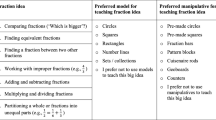Abstract
This paper analyzes the interpretations of equality and the equal symbol of the third-grade children who participated in a year long whole-class socio constructivist teaching experiment. These children initially interpreted the equal symbol as a command to perform an arithmetical operation; it was less natural to them to interpret it as a relational symbol to compare two quantities. By the end of the school year, children were able to conceptualize the ‘quantitative sameness’ of two numerical expressions and describe it by using the phrase ‘is the same as’, the words ‘equal’ or ‘equals’, or the symbols ‘=’ or ‘=s’. These children expanded their conceptualizations of equality due to their active role in class discussions, the arithmetical tasks that took into account children's difficulties, and the teacher's intellectual sensitivity to ‘strike a delicate balance between the force of teaching and the freedom of learning’ (Freudenthal, 1991, p. 55).
Similar content being viewed by others
REFERENCES
Behr, M., Erlwanger, S., & Nichols, E.: 1980, ‘How children view the equal sign’, Mathematics Teaching 92, 13-15.
Blumer, H.: 1969, Symbolic Interactionism: Perspective and Method, University of California Press, Berkeley.
Bruner, J.: 1986, Actual Minds, Possible Worlds, Harvard University Press, Cambridge.
Cajori, F.: 1974/1928, A History of Mathematical Notation: Notations in Elementary Mathematics (vol. 1), The Open Court Publishing Company, La Salle.
Cobb, P. and Steffe, L. P.: 1983, ‘The constructivist researcher as teacher and model builder’, Journal for Research in Mathematics Education 14, 83-94.
Davis, P. J. & Hersh, R.: 1981, The Mathematical Experience, Houghton Mifflin, Boston.
Dewey, J.: 1938, Experience and Education, Collier Books, New York.
Peirce, C. S.: 1976, The New Elements of Mathematics, vol. 4 (edited by Carolyn Eisele, 4 vols.), Mouton Publishers, The Hague.
Freudenthal, H.: 1983, Didactical Phenomenology of Mathematical Structures, Kluwer Academic Publishers Group, Boston.
Freudenthal, H.: 1991, Revisiting Mathematics Education, Kluwer Academic Publishers Group, Boston.
Gravemeijer, K.: 1994, ‘Educational development and developmental research in mathematics education’, Journal of Research in Mathematics Education 5, 443-471.
Hawkins, D.: 1966, ‘Learning the unteachable’, in L. S. Shulman & E. R. Keislar (eds.), Learning by Discovery,Rand McNally and Company, Chicago, pp. 3-11.
Hoopes, J. (ed.): 1991, Peirce on Signs, The University of North Carolina Press, Chapel Hill.
Mead, G. H.: 1934, Mind, Self, and Society, University of Chicago Press, Chicago.
Piaget, J.: 1985. The Equilibration of Cognitive Structures, University of Chicago Press, Chicago.
Sinclair, H.: 1990, ‘Learning the interactive recreation of knowledge’, in L. P. Steffe and T. Wood (eds.), Transforming Children's Mathematical Knowledge: International Perspectives, Lawrence Erlbaum Associates, Hillsdale, pp. 19-29.
Steffe, L. P.: 1983, ‘The teaching experiment methodology in a constructivist research program’, in M. Zweng, T. Green, J. Kilpatrick, H. Pollak, and M. Suydam (eds.), Proceedings of the Fourth International Congress on Mathematical Education, Birkhauser, Boston, pp. 469-471.
Author information
Authors and Affiliations
Rights and permissions
About this article
Cite this article
Sáenz-Ludlow, A., Walgamuth, C. Third Graders' Interpretations of Equality and the Equal Symbol. Educational Studies in Mathematics 35, 153–187 (1998). https://doi.org/10.1023/A:1003086304201
Issue Date:
DOI: https://doi.org/10.1023/A:1003086304201




